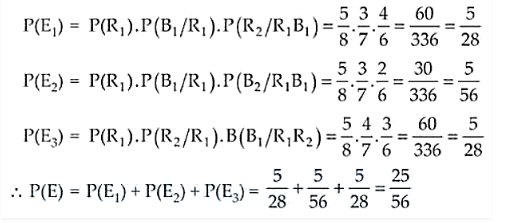Question:
A bag contains 5 red marbles and 3 black marbles. Three marbles are drawn one by one without replacement. What is the probability that at least one of the three marbles drawn be black, if the first marble is red?
Solution:
Let red marbles be presented with R and black marble with B. Also, let E be the event that at least one of the three marbles drawn be black when the first marble is red.
Now, the following three conditions are possible, if atleast one of the three marbles drawn be black and the first marble is red.
(i) E1: 2nd ball is black and 3rd ball is red
(ii) E2: 2nd ball is black and 3rd ball is also black
(iii) E3: 2nd ball is red and 3rd ball is black
The probabilities of the above events are:

Therefore, the required probability is 25/56.
